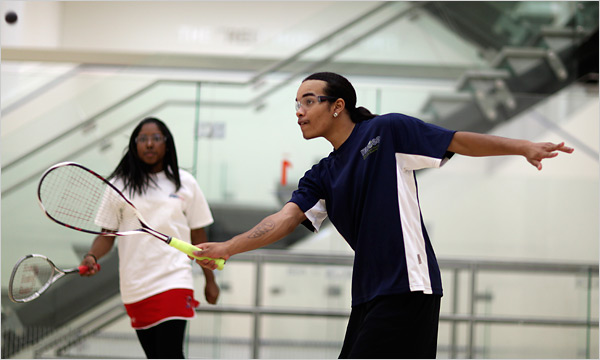

Diosmiry Rodriguez and Joshua Gary on the court at the StreetSquash center on
115th Street.
With his tie gone long before he had arrived, Joshua Gary needed only a few minutes to change out of his public high school’s mandatory black sweater and slacks and into his squash gear: white shoes, shorts, clear protective glasses. Screeches of excitement and sneakers echoed across the eight courts as he joined Jamel Key, 17, and Jennifer Moses, 18.
The three college-bound seniors from Thurgood Marshall Academy, friends since junior high, dodged and glided their way to and from the red “T” at the center, the ball hugging the right wall with each shot.
Less than two weeks remained before they would graduate from StreetSquash, an intensive program that combines athletics and academics, and they seemed to be getting in all the shots they could. Each of the students would be heading to college, but none where they could play squash for their school.
“Squash is the vehicle,” said George Polsky, the executive director of StreetSquash, which after nearly 10 years of borrowing courts around Manhattan will graduate its first class from a spacious new home in Harlem this week. “It means more to me to help them figure out a math problem than how to hit a serve.”
While StreetSquash has no entrance requirements, each potential student is evaluated during a monthlong trial where attendance is paramount. Miss more than a couple of sessions without an excuse, Mr. Polsky said, and students may find that StreetSquash is not for them. The four-day-a-week commitment is substantial: two days of homework and squash, one day of SAT prep (for high school students) or literacy education (for sixth to eighth graders), and Saturday, which is reserved for squash.
“It’s been nothing but beneficial,” said Diosmiry Rodriguez, 17, who started playing squash in the seventh grade and will graduate next year from Thurgood Marshall. “When they came to my school to talk about it, I didn’t know what squash was; I thought it was a vegetable.” At first, she was interested in homework help, she said, but grew to enjoy playing: “I didn’t try, but now I try.”
Using squash as a tool for academic advancement in urban settings occupies a small but growing niche, said Greg H. Zaff, creator of Boston’s SquashBusters, one of the first such programs in the country. With Mr. Polsky and the directors of CitySquash in the Bronx and SquashSmarts in Philadelphia, Mr. Zaff began a national organization three years ago to support nascent programs, each with rigorous standards of commitment. “This isn’t about just rounding up kids and putting them on a squash court on Saturdays,” he said.
The organization, the National Urban Squash and Education Association, counts nine programs as members, with the most recent, in Baltimore, joining Thursday. A few others, including programs in Cleveland, San Francisco and Toronto, are in the works.
Students from each program get together for tournaments in the winter and summer. This year’s summer competition, at Williams College in Massachusetts at the end of June, will include students from all nine programs.
“All these things were sort of bubbling up locally,” Mr. Zaff said. “We wanted to take a lead role in building upon the momentum.”
If higher education is the goal, it has been a large part of the means as well.
With few squash options available in New York City, Mr. Polsky came to an agreement in 1999 with Columbia University and the Harvard Club to use their courts. Similarly, Squash Haven, in New Haven, practices at the Yale courts; SquashSmarts uses courts at Drexel University; and the SquashBusters’ center is on the campus of Northeastern University in Boston.
At first, the Harvard Club “freaked the kids out a little,” said Mr. Polsky, who belongs to the club. “There were animal heads on the wall, and white people.”
The program began with 24 students, and has grown to about 150 students who enjoy a new $9 million permanent home that opened in November on 115th Street, west of Fifth Avenue.
The new center also benefits the Columbia squash club team, which began practicing and holding tournaments this season on the regulation-size courts there. The university plans to add squash as a varsity sport in 2011, a move made possible by the new courts.
Extending the role reversal, StreetSquash – which had paid Columbia $10,000 a year to play on the university’s wooden courts – now receives five times that amount from the university for the use of its larger, gleaming new composite courts. As part of the contract, Columbia players also spend five hours a month either teaching squash or tutoring the students in a variety of subjects.
Despite some recent attention to the perceived advantage that the sport can give applicants to top universities, most colleges – including those in the State University of New York system – do not offer varsity squash. While a handful of StreetSquash alumni have been accepted at schools like Franklin & Marshall and Wesleyan, where the sport is played, one of the ironies of the program is that most of its graduates will not play squash in college, even though it helped get them there.
But Mr. Gary, 18, who will attend SUNY Delhi, and Mr. Key, who will attend SUNY Canton, have a plan for how to continue.
They both intend to study hard their freshman year, and then transfer to St. Lawrence University, also in Canton, where squash is a varsity sport.